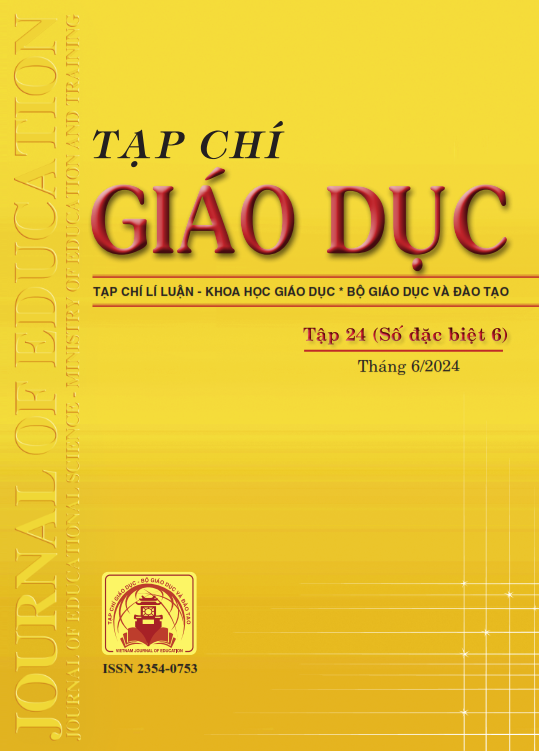Vận dụng mô hình CACAO trong giảng dạy STEM tại Trường Đại học Nguyễn Tất Thành
Tóm tắt
The effectiveness of initiatives aimed at reforming teaching and learning is a vital component of any attempt to enhance student outcomes in STEM. Course-based practices, community values, and institutional regulations and structures related to teaching and learning in higher education are all being changed as part of reform initiatives. This research evaluated the usefulness of a theory-based change model used in an institution of higher learning. Our findings offer direction for reform initiatives in Vietnamese universities. The reform of STEM education at Nguyen Tat Thanh University was guided by the CACAO model, which produced modifications to departmental culture and faculty teaching techniques that were in line with the project's vision. The importance of project activities at the departmental level determines how these changes differ throughout STEM departments. The study has clarified the utility of the CACAO model in facilitating change, analyzing its key elements in a matrix to lay the foundation for further research on the change process. The research emphasizes the importance of applying change theory in practice, creating a framework that others can adapt and modify to suit their specific circumstances.
Tài liệu tham khảo
Andrews, T. C., Conaway, E. P., Zhao, J., & Dolan, E. L. (2016). Colleagues as Change Agents: How Department Networks and Opinion Leaders Influence Teaching at a Single Research University. CBE-Life Sciences Education, 15(2), 1-17. https://doi.org/10.1187/cbe.15-08-0170
Bathgate, M. E., Aragón, O. R., Cavanagh, A. J., Waterhouse, J. K., Frederick, J., & Graham, M. J. (2019). Perceived supports and evidence-based teaching in college STEM. International Journal of STEM Education, 6(1), 1-14. https://doi.org/10.1186/s40594-019-0166-3
Borrego, M., & Henderson, C. (2014). Increasing the Use of Evidence-Based Teaching in STEM Higher Education: A Comparison of Eight Change Strategies. Journal of Engineering Education, 103(2), 220-252.
Dormant, D. (2011). The Chocolate Model of Change (First Edition). Lulu.com.
Earl, B., Viskupic, K., Marker, A., Moll, A., Roark, T., Landrum, R. E., & Shadle, S. (2020). Driving Change: Using the CACAO Framework in an Institutional Change Project. https://openbooks.library.umass.edu/ascnti2020/ chapter/earl-etal/
Elrod, S., & Kezar, A. (2017). Increasing Student Success in STEM: Summary of A Guide to Systemic Institutional Change. Change: The Magazine of Higher Learning, 49(4), 26-34. https://doi.org/10.1080/ 00091383.2017.1357097
Grunspan, D. Z., Kline, M. A., & Brownell, S. E. (2018). The Lecture Machine: A Cultural Evolutionary Model of Pedagogy in Higher Education. CBE-Life Sciences Education, 17(3), es6. https://doi.org/10.1187/cbe.17-12-0287
Hall, G. E., & Hord, S. M. (2010). Implementing Change: Patterns, Principles, and Potholes (3rd edition). Boston: Pearson.
Harris, R. B., Mack, M. R., Bryant, J., Theobald, E. J., & Freeman, S. (2020). Reducing achievement gaps in undergraduate general chemistry could lift underrepresented students into a “hyperpersistent zone”. Science Advances, 6(24), 1-8. https://doi.org/10.1126/sciadv.aaz568
Landrum, R. E., Viskupic, K., Shadle, S. E., & Bullock, D. (2017). Assessing the STEM landscape: The current instructional climate survey and the evidence-based instructional practices adoption scale. International Journal of STEM Education, 4(1), 25. https://doi.org/10.1186/s40594-017-0092-1
Marbach-Ad, G., & Hunt Rietschel, C. (2016). A Case Study Documenting the Process by Which Biology Instructors Transition from Teacher-Centered to Learner-Centered Teaching. CBE Life Sciences Education, 15(4), 1-15. https://doi.org/10.1187/cbe.16-06-0196
Reinholz, D. L., White, I., & Andrews, T. (2021). Change theory in STEM higher education: A systematic review. International Journal of STEM Education, 8(1), 37. https://doi.org/10.1186/s40594-021-00291-2
Rogers, E. M. (2003). Diffusion of Innovations (5th Edition). Simon and Schuster.
Seymour, E., & Hunter, A.-B. (2019). Talking about Leaving Revisited: Persistence, Relocation, and Loss in Undergraduate STEM Education. Springer International Publishing.
Theobald, E. J., Hill, M. J., Tran, E., Agrawal, S., Arroyo, E. N., Behling, S., … Freeman, S. (2020). Active learning narrows achievement gaps for underrepresented students in undergraduate science, technology, engineering, and math. PNAS Proceedings of the National Academy of Sciences of the United States of America, 117(12), 6476-6483. https://doi.org/10.1073/pnas.1916903117
Trường Đại học Nguyễn Tất Thành (2020). Kế hoạch số 30/KH-QLĐT ngày 25/02/2020 về việc Tập huấn dự án áp dụng và khảo sát mô hình CACAO tại Trường Đại học Nguyễn Tất Thành.
Walter, E. M., Beach, A. L., Henderson, C., Williams, C. T., & Ceballos-Madrigal, I. (2021). Understanding Conditions for Teaching Innovation in Postsecondary Education: Development and Validation of the Survey of Climate for Instructional Improvement (SCII). International Journal of Technology in Education, 4(2), 166-199. https://doi.org/10.46328/ijte.46
Đã Xuất bản
Cách trích dẫn
Số
Chuyên mục
Giấy phép

Tác phẩm này được cấp phép theo Ghi nhận tác giả của Creative Commons Giấy phép quốc tế 4.0 .












